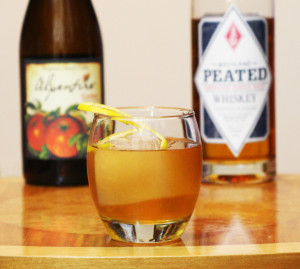For someone whose years of formal schooling focused on things like the Krebs cycle and the shape of electron shells, little attention was paid to history. A plunge into the fascinating world of cider and orchards, however, has reveled just how closely intertwined the history of America and the history of American cider truly are. A case in point is the incredibly flexible, wonderfully delicious cocktail, the Stone Fence.
Great Britain’s American colonies had been producing cider practically from the moment the first ships landed in the New World. Cider was tasty, easy to make, and safe to drink, and a well laid out orchard was comforting evidence of man’s ability to create order in a new and sometimes hostile wilderness. Over time, the men and women that had taken a chance on carving out a life so far from their origins began to chafe under the rule of a far away government that so often seemed to impose onerous taxes while giving little back in return. By April of 1775 discontent had come to a head and the first shots of revolution fired in the small Massachusetts towns of Lexington and Concord (enterprising local Elias Brown sold mugs of cider to soldiers on both sides as well a spectators that had come to find out just what all the fuss was about.) The war for independence had begun.
Several years earlier, King George III had provoked a land dispute when he gave the colonial governor of New York the right to sell land grants to the west of New Hampshire (territory that would later become Vermont), the same land that the governor of New Hampshire was already selling. Those with grants from New Hampshire were understandably incensed that someone else was set to claim lands that they thought of as rightfully theirs. After unsuccessfully trying to resolve the issue in the New York courts, the New Hampshire grant holders turned to the only option open to them, a local militia whose mandate was to keep the New Yorkers out! Thus was born the Green Mountain Boys under the leadership of the brash and argumentative Ethan Allen. Allen and his Boys were pretty successful, eventually ending up with a price on their heads, but in the wake of Lexington and Concord, it became obvious that there were bigger issues at stake.
In early May of 1775 the revolutionary shadow government of nearby Connecticut got word to Allen that they were planning on capturing Fort Ticonderoga, located on Lake Champlain, and asking if he and his Boys would join them. A strategically important fort that had only been lightly garrisoned since the end of the French and Indian Wars, Fort Ticonderoga still had a fine collection of cannon and other armaments that were were sorely needed by the new revolutionary forces and so would be a useful prize. Allen was always up for a good scrap, so he began assembling a force in the small town of Castleton, about 50 miles from the fort. What he didn’t know was that Benedict Arnold, a newly commissioned colonel, was heading north on the same mission. They met in Castleton, probably at the town’s one tavern, the Catamount owned by one Zadock Remington.
Most colonial towns had few if any civic buildings, making taverns de facto sites for every sort of meeting. In this case, meeting at a tavern undoubtably had its benefits, for although Arnold had an official commission and orders to lead the mission most of the assembled company was unwilling to follow anyone but Allen. As the story goes, all sat down for cups of the local tipple – cider mixed with rum, that other New England staple – a compromise was reached, and the fort was easily captured the next day. The confiscated canons were used six months later to drive the British troops from Boston effectively ending major military activity in New England.
At what point the mix of rum and cider became known as a Stone Fence isn’t clear. Over time, though, taverns across the land would serve cider mixed with whatever spirit was made locally – rum in New England, rye in Pennsylvania, bourbon in Kentucky, or applejack in New Jersey. By the time anyone got around to writing the first bar manual, the Stone Fence had been enfeebled by exchanging cider for sweet apple juice. This version of the Stone Fence isn’t awful, but it lacks a certain thrill. A better approach is to follow the lead of Ethan and his Boys. Take a bottle of your favorite local cider and mix it 1:1 with something from your favorite local distillery, preferably something barrel-aged.
The following version was inspired by a recent trip to Washington, home to some very happening distilleries and some amazing ciders. Alpenfire’s Ember, a certified organic cider made by husband and wife team Steve (Bear) and Nancy Bishop in Port Townsend, WA, is a complex semi-dry blend of French and English bittersweets whose pronounced tannins give the cider an appealing astringency that rounds out its rich fruit flavors. Combine it with Peated, a gold medal winning smoky single malt from Seattle’s Westland Distillery, and you’ll have a cocktail that will light any party on fire.
Stone Fence
-
-
- 1 1/2 ounces Peated Westland Whisky
- 1 1/2 ounce Alpenfire Ember cider
- a twist of lemon peel as a garnish
-
Pour the whisky into a low ball glass, add the cider, and some ice (use a big cube if you want to keep the drink cold but not watered down), and a twist of lemon peel.
